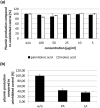Linoleic and palmitoleic acid block streptokinase-mediated plasminogen activation and reduce severity of invasive group A streptococcal infection
- PMID: 28924140
- PMCID: PMC5603603
- DOI: 10.1038/s41598-017-11276-z
Linoleic and palmitoleic acid block streptokinase-mediated plasminogen activation and reduce severity of invasive group A streptococcal infection
Abstract
In contrast to mild infections of Group A Streptococcus (GAS) invasive infections of GAS still pose a serious health hazard: GAS disseminates from sterile sites into the blood stream or deep tissues and causes sepsis or necrotizing fasciitis. In this case antibiotics do not provide an effective cure as the bacteria are capable to hide from them very quickly. Therefore, new remedies are urgently needed. Starting from a myxobacterial natural products screening campaign, we identified two fatty acids isolated from myxobacteria, linoleic and palmitoleic acid, specifically blocking streptokinase-mediated activation of plasminogen and thereby preventing streptococci from hijacking the host's plasminogen/plasmin system. This activity is not inherited by other fatty acids such as oleic acid and is not attributable to the killing of streptococci. Moreover, both fatty acids are superior in their inhibitory properties compared to two clinically used drugs (tranexamic or ε-amino caproic acid) as they show 500-1000 fold lower IC50 values. Using a humanized plasminogen mouse model mimicking the clinical situation of a local GAS infection that becomes systemic, we demonstrate that these fatty acids ameliorate invasive GAS infection significantly. Consequently, linoleic and palmitoleic acid are possible new options to combat GAS invasive diseases.
Conflict of interest statement
The authors declare that they have no competing interests.
Figures






Similar articles
-
The role of streptokinase as a virulence determinant of Streptococcus pyogenes--potential for therapeutic targeting.Curr Drug Targets. 2012 Mar;13(3):297-307. doi: 10.2174/138945012799424589. Curr Drug Targets. 2012. PMID: 22206253 Review.
-
Characterization of streptokinases from group A Streptococci reveals a strong functional relationship that supports the coinheritance of plasminogen-binding M protein and cluster 2b streptokinase.J Biol Chem. 2012 Dec 7;287(50):42093-103. doi: 10.1074/jbc.M112.417808. Epub 2012 Oct 18. J Biol Chem. 2012. PMID: 23086939 Free PMC article.
-
Group a Streptococcus remains viable inside fibrin clots and gains access to human plasminogen for subsequent fibrinolysis and dissemination.Microbiol Spectr. 2025 Feb 4;13(2):e0260724. doi: 10.1128/spectrum.02607-24. Epub 2025 Jan 13. Microbiol Spectr. 2025. PMID: 39804237 Free PMC article.
-
Streptokinase variants from Streptococcus pyogenes isolates display altered plasminogen activation characteristics - implications for pathogenesis.Mol Microbiol. 2012 Dec;86(5):1052-62. doi: 10.1111/mmi.12037. Epub 2012 Oct 29. Mol Microbiol. 2012. PMID: 23106864
-
Uncovering the mysteries of invasive streptococcal diseases.Trends Mol Med. 2005 Apr;11(4):152-5. doi: 10.1016/j.molmed.2005.02.001. Trends Mol Med. 2005. PMID: 15823752 Review.
Cited by
-
The intricate pathogenicity of Group A Streptococcus: A comprehensive update.Virulence. 2024 Dec;15(1):2412745. doi: 10.1080/21505594.2024.2412745. Epub 2024 Nov 5. Virulence. 2024. PMID: 39370779 Free PMC article. Review.
-
Determination of Free Fatty Acids in Breast Milk Reveals the Presence of Hydroxypalmitic and Stearic Acids.Biomolecules. 2024 Dec 14;14(12):1602. doi: 10.3390/biom14121602. Biomolecules. 2024. PMID: 39766309 Free PMC article.
-
Bacterial Outer Membrane Permeability Increase Underlies the Bactericidal Effect of Fatty Acids From Hermetia illucens (Black Soldier Fly) Larvae Fat Against Hypermucoviscous Isolates of Klebsiella pneumoniae.Front Microbiol. 2022 May 6;13:844811. doi: 10.3389/fmicb.2022.844811. eCollection 2022. Front Microbiol. 2022. PMID: 35602017 Free PMC article.
-
Bacterial Diversity of Breast Milk in Healthy Spanish Women: Evolution from Birth to Five Years Postpartum.Nutrients. 2021 Jul 14;13(7):2414. doi: 10.3390/nu13072414. Nutrients. 2021. PMID: 34371924 Free PMC article.
References
Publication types
MeSH terms
Substances
LinkOut - more resources
Full Text Sources
Other Literature Sources
Medical

